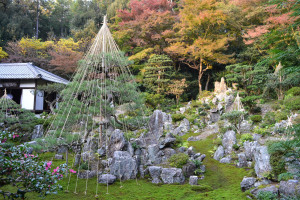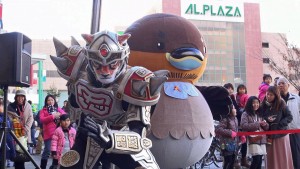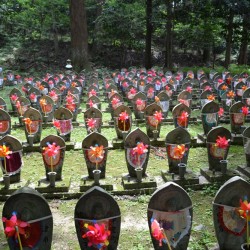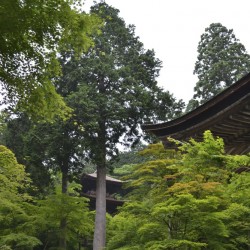Kotosanzan Temples Offer a Glimpse of Medieval Japan
Despite being known as the rainy season, June is often a great time to be outside in Shiga. The summer heat hasn’t taken over yet, and the foliage is as green as it gets. We found the perfect excuse to get some fresh air last Tuesday, when we arranged a visit to three of the oldest Temples in Shiga, collectively known as Kotosanzan (湖東三山 – or 3 mountains east of the lake). We were also lucky enough to meet with the head monks of the temples who gave us plenty of interesting backstory to put all of this ancient beauty into a fascinating narrative context. My wife, and our defacto Be Wa translator, was a big help during the visit since my Japanese skills are sorely lacking in topics like ancient history or religious philosophy, but the Temples do have English brochures as well, so don’t worry if you don’t have a translator for your visit.
Overall this was a great day trip that I’d recommend to anyone, but getting there by public transportation may be an initial hurdle. The nearest train station is Amago (尼子駅) a few kilometers west on the local Ohmi line, and from here your options are taxi, a 30+ minute walk, or possibly bike rentals (not sure about bikes though, we’ll update or comment if we find out more). There is also a sort of taxi-bus system catering to these temples that run from nearby stations or between the temples, but routes are somewhat limited and reservation (Japanese only) is required an hour in advance.
Before getting into our visit, I’ll do my best at a brief historical overview for some context, so you history buffs can either skip ahead, or tell me all the facts I’m getting wrong.
Let’s start back around 794 AD, when the Japanese capitol moved from Nara to Kyoto. This was also just after the Tendai sect of Buddhism had been founded, and it was headquartered at the Enryakuji Monastery on Otsu’s Mt. Hiei, which sits on the Shiga-Kyoto border. At that time, Tendai Buddhism flourished under patronage from the imperial family and local nobility. From this point forward, Tendai heavily influenced many if not all philosophers and sects of Japanese Buddhism that would grow over the following centuries.
Not unlike the power of the Catholic church in medieval Europe, some Buddhist Monasteries were being built and run more like castles
Jumping ahead to the Sengoku period of warring clans, Oda Nobunaga famously began unifying Japan and paving the way for the stability that would come in the Edo period. But unification also involved the messy business of dealing with opposing clans. The Tendai sect was not only aligned with the opposing Azai clan, but the sect had also grown to the point of influencing local governments, controlling economies, and more importantly becoming militarized. Not unlike the power of the Catholic church in medieval Europe, some Buddhist Monasteries were being built and run more like castles than temples.
So the end result, and the point I’m getting to with all of this, was that Nobunaga finally burned down many of the Tendai temples including the Enryakuji Monastery and most of the Kotosanzan temples. The main halls at two of the three Kotosanzan temples survived and those halls date back to the Kamakura period, but the oldest and biggest temple complex, Hyakusaiji, was almost entirely destroyed.
There are plenty more stories about Tendai, Nobunaga, warrior monks, etc but you’ll have to google them for yourself; we still have the temples to get to, so let’s get to our trip:
Saimyoji Temple – 西明寺
Stepping out of the car, we’re immediately drawn in by the massive old-growth cedar trees overhead and the mossy landscape beneath. All three of these temples have carefully arranged rock and flower gardens, but the entirety of the surrounding temple grounds is also beautifully maintained. Compared to tourist areas like Kyoto or Nara, these local temples offer a much better environment to relax and connect with nature uninterrupted. In autumn, the changing leaves of the Japanese maples attract a lot of visitors here, but this season is perfect for a quiet getaway.
Amazingly the entire hall and 3 story pagoda are constructed entirely of wood, without any nails.
Once we made our way up to the main hall, we met the head monk who was happy to answer any questions. He pointed out some of the details of the Kamakura period architecture, such as the kaerumata curved support beams so called for their frog-like shapes and the overall level of craftsmanship that went into many details such as the latticed ceiling. Amazingly, the entire hall and adjacent 3 story pagoda are constructed entirely of wood, without any nails. This sort of construction lasts surprisingly well as it allows the joints and interlocking pieces to move with each other over time as the wood changes shape, and it helps withstand earthquakes by allowing the structure to flex and move in response to tremors. The main halls of all 3 temples have ornately decorated altars surrounded by numerous statues, religious artifacts, etc. But each of the temples has a different primary deity at the focal point of the altar. At Saimyoji, this honor is given to Yakushi Nyorai (薬師如来, the buddha of healing and medicine). There is a corridor circling around the back of the altar where we could see even more artifacts, many of which are designated as national treasures.
After visiting the garden once more, we made our way back to the car and prepared for temple number 2.
Kongorinji Temple – 金剛輪寺
After a few short minutes by car, we arrived at Kongorinji. Like Saimyoji, Kongorinji also has a garden, original Kamakura period main hall and 3 story pagoda, but one unique attraction here is the 2000 “Jizo” statues that line the path through the woods toward the main hall. The Jizo bodhisattva is an important figure, but is particularly prevalent here in Shiga. We’ll probably have to tackle Jizo in more detail when Jizo Obon season rolls around. These small statues led the way for our 500 meter hike up to the main hall, each stone statue cared for by local residents, most clothed in red and holding decorative pinwheels; it was defintely a bit of a workout, but the scenery along the way was well worth it. And like Saimyoji, this entirely nailless wooden Kamakura period hall houses many relics and treasures, but the main figure for worship here is Kannon ( 観音菩薩, or goddess of mercy). The design and construction of the Saimyoji’s main hall may have been a bit higher quality (I’m no expert of course), but this one seemed more integrated into the surrounding mountain landscape. The temple grounds here also includes a small udon & soba shop which we hit just in time for a much needed meal and break before our final stop.
Hyakusaiji Temple – 百済寺
Hyakusaiji was a little further, but still withn a few kilometers, tucked away on a small mountain. This is the oldest of Kotosanzan temples, originally established in 609 by Prince Shotoku (聖徳太子), who is credited for Japan’s first major constitution and was also a strong advocate for Buddhism in Japan.
The kanji for the name Hyakusai (百済) are also pronounced “kudara,” which is the Japanese word for the ancient Korean peninsula. There was apparently some immigrant population from Kudara here in Shiga, and the head monk explained to us that there was originally a sister temple back it Korea. Hyakusaiji’s main hall faces west toward the Korean peninsula, and the sister temple faced east toward Shiga, but that sister temple was destroyed by fire and never rebuilt.
By the time Nobunaga arrived in the 16th Century, this temple had grown into an entire community with hundreds of buildings. As it grew, Hyakusaiji had also become militarized and fortified for protection. The head monk pointed out that much of the fortifying was more castle-like than temple. So much so that the temple now attracts attention from castle scholars.
The central deity, a 3-meter-tall statue of the 11 faced Kannon, survived Nobunaga’s fires and is enshrined in the current Edo-period main hall. I should mention that all of these temples, like many temples around Japan, keep the central deity of worship closed in an altar box, only to be opened on rare or special occasions. It was closed during our visit, but there were numerous other artifacts and national treasures on display. This was the only Kotosanzan temple at which the monk allowed us to take photos inside the main hall, so a couple of these treasures are shown in the photos above. Note – the rule of thumb is no photos in Japanese temples, so be sure to get permission!
So that about does it for our trip! Despite dropping a lot of history and religion here, during the actual visit we were mostly just enjoying the scenery. But it’s a great place for enjoying both, and as I’m quickly discovering, that goes for much of Shiga in general.
湖東三山で「日本の中世」を垣間見る
梅雨の季節として知られる6月です。この時期にあえてどこかへ出掛けるのも良いものです。夏の熱気はまだ感じられないし、山の緑が一層鮮やか。先週の火曜日、新鮮な空気を求めるという名目で、湖東三山として知られる滋賀県の3つの古寺を訪れました。それぞれのお寺のご住職からお聞きした様々な興味深いお話を知識のバックグラウンドに、これら古寺に息づく悠久の美を壮大なストーリーとして感じてきました。 歴史や宗教哲学に関する私の日本語の語彙が乏しいこともあり、私の妻、もといBeWaの通訳担当がいたことは大きな助けでしたが、英語のパンフレットもおいてあるので通訳してくれる人と一緒でなくても心配はないでしょう。湖東三山への旅はとても素晴らしく強くおすすめしたいところですが、唯一、公共交通機関が問題でお寺にたどり着くのがまず最初の難関かもしれません。一番近い鉄道の駅が数キロ離れた尼子駅になり、そこからはタクシー、もしくは30分以上の徒歩、そしてレンタサイクルなどで行くことができます。(レンタサイクルのことについて詳しい事はまた追々お知らせする事にいたしましょう)それ以外でもバスとタクシーが一緒になったようなシステムが、最寄りの駅からお寺まで、及びお寺間を走っていますが、ルートが少し限定されており、又それを利用するには1時間前までに予約する必要が有ります(日本語対応のみ)。
まずは、私的にベストを尽くし簡単な歴史背景の紹介から始めたいと思います。もし歴史マニアがこれを読んでいたら…。読み飛ばすか、もしくは間違いを指摘してくださいね!
時は794年にさかのぼります。日本の首都が奈良から京都へ移されました。これはちょうど仏教の宗派、天台宗が開かれたときと重なります。天台宗は総本山を京都と滋賀の境に位置する比叡山の延暦寺に置き僧院を開きました。天台宗は天皇や貴族の庇護を受けこの時代に大きく発展しました。天台宗は全部とはいわなくとも大きな部分で、日本の宗教哲学、そのあとの時代に発展するその他の仏教宗派に大きく影響を及ぼしていったのです。
中世ヨーロッパにおけるカトリック教会の存在とよく似ており、中には寺院というより城郭のように建てられ又そのように運営されるようなところもあった
日本を統一に導きその後に続く江戸時代の平安をもたらしたとして有名な織田信長の戦国時代まで時は進みます。天下統一への道はしかし、信長と敵対する氏族との対立を招くことになりました。天台宗は信長と対立する浅井氏につくばかりでなく、政治に影響を及ぼし、経済を牽引し、そして挙句の果てには軍事力を持つまでになります。これは中世ヨーロッパにおけるカトリック教会の存在とよく似ており、中には寺院というより城郭のように建てられ又そのように運営されるようなところもありました。
この話の結末は…?信長は天台宗である比叡山をはじめ湖東三山の大半を焼いてしまいました。湖東三山のうち2つの寺院の本堂は焼けずに残ったため、これらの本堂は鎌倉時代の姿を残しています。しかし、その中の一つ、百済寺についてはその全てをほとんど戦火で失ってしまいました。
天台宗、織田信長、僧兵などそれらにまつわる話はまだまだたくさんありますが、肝心のお寺のお話しをしなくてはならないので、それについては各自Googleしてください。それでは、実際のレポートにいってみましょう!
Saimyoji Temple – 西明寺
車から降り立つなり、頭上には生い茂る巨大な杉と、足下には苔むした地面が続くその景色に心を惹かれました。今回訪れたお寺全ての庭園では石や花に至るまで綿密に計算され配置されていましたが、お庭のみならず敷地内が全体としてとても綺麗に整えられていました。京都や奈良などの観光スポットに比べて、こちらでは雑踏から離れ誰にも邪魔されずゆっくりと自然との調和を楽しむことができるように思います。秋には色づいた紅葉が沢山の観光客を呼びますが、静寂をもとめて過ごすならこの季節が一番です。
驚いたのは、本堂、そしてその横にたつ三重塔どちらにも一本の釘も使われていないということだ
本堂までたどり着くとお寺のご住職が私たちの様々な質問に快く答えて下さいました。カエルの足に良く似た形状から蟇股(かえるまた)と呼ばれる建物を支える梁のようなカーブのついた細工、そして格子天井などといった細かい技が見てとれる鎌倉時代の技術の高さについて特に詳しい説明を聞きました。驚いたのは、本堂、そしてその横にたつ三重塔どちらにも一本の釘も使われていないということです。このような建造物は時間の経過とともに木材が変形しても、結合部分がそれに合わせて動くため非常に寿命が長く、また地震がきても揺れに対して遊びがあることで構造的に強い作りになっているようです。本堂の中心にはご本尊が収められた厨子があり、周りには沢山の仏像や仏教にまつわる文化財などが囲んでいます。この配置は三寺に共通していますが、お祀りするご本尊はそれぞれのお寺で違っています。ここ西明寺では薬師如来がまつられています。厨子の後ろ側にも行ける通路が側にあり、そこにもまた数々の国宝に指定されている文化財が並びます。
本堂を下りもう一度お庭を訪れた後、私たちは次の目的地に向かいました。
Kongorinji Temple – 金剛輪寺
数分のドライブの後、私たちは金剛輪寺に降り立ちました。お庭や鎌倉時代に建てられた本堂と三重塔などがあるところは西明寺と同じです。ここ金剛輪寺でその他特筆して目を引くのが、本堂に続く参道にずらっと並ぶ二千体のお地蔵さんです。地蔵菩薩は仏教ではメジャーな存在ですが、特にここ滋賀県ではそれが顕著です。お地蔵様については、地蔵盆が近づく季節にまた詳しく紹介するとします。これら小さなお地蔵様が並んだ参道を500メートルほど本堂に向かい登って行きます。この地域の家庭がそれぞれのお地蔵様のお世話をしているようで、お地蔵様達は赤い服を着せてもらい風車を手に持っています。ここの参道を登るには少し体力がいりますが、それでもこの風景を見る価値はあります。西明寺と同様に釘を一本も使用していない本堂の中には、例にもれず数々の文化財や国宝がおさめられていますが、このお寺のご本尊は観音菩薩です。デザイン的、建造物的に本堂を見ると西明寺の物の方が優れているように思いますが(といっても専門家ではありませんのであしからず)、そのかわりこちらのほうが建物が山の風景と融合しているような感じがします。また、このお寺にはうどんやそばを提供している小さなお店があり、次の目的地に行くまでお腹を満たさなければならなかった私たちにはうってつけでした。
Hyakusaiji Temple – 百済寺
百済寺は他のお寺より少し離れていますが、それでも数キロメートルの範囲内にあります。小さな山の中腹に佇むお寺です。三寺の中で一番歴史が古く、日本で最初の憲法を作り、又仏教を積極的に広めた聖徳太子によって609年に建立されました。百済寺の「百済」は「くだら」とも読み、古代朝鮮半島もそう呼ばれています。その時代、ここ滋賀にも百済から移り住んだ人達がいたことが分かっており、ご住職によるとその昔、百済寺の姉妹的なお寺が朝鮮半島にも存在したとの事でした。百済寺本堂はその姉妹寺の方角を向いており、同じようにそちらのお寺も百済寺の方向を向いてお互いに向き合っていたと言う事です。しかし、その後朝鮮半島にあるそのお寺は焼失してしまいそのまま再建されることはありませんでした。16世紀に信長が台頭するまで、百済寺は数百の建造物を有する一大コミュニティーを形成していきました。その過程で軍事化がされ要塞の体をなすようにもなっていきました。ご住職の話では、それはお寺というよりお城と呼ぶ方がしっくりくるほどのものだったということです。そのため今では城郭研究の対象ともなっています。
信長の焼き討ちから唯一生き残った3メートルもある高さの十一面観音像のご本尊は、今は江戸時代に建設された本堂に祀られています。日本国内のその他のお寺と同じように、この湖東三山でもご本尊の姿は厨子に収められ、特別な機会のみその扉を開けることが許されています。私たちが訪れた時、扉はしまっていましたがその他のたくさん国宝や文化財を見る事ができます。今回は、ここ百済寺でのみ本堂内の写真を撮る許可を得ましたので、いくつかその写真を掲載しました。注:基本的には日本のお寺では写真撮影を禁止している場合が多く、撮影する場合は許可がいります!
今回はここまでとしましょうか。本記事の中では歴史や宗教の事にも触れましたが、実際に訪れている間は、素晴らしい景観をただ単純に満喫していました。歴史・文化と景観どちらを求めても満足できるところです。そう思うと同時に、それはここ滋賀のその他のところにも共通する魅力だと改めて思い至りました。









































